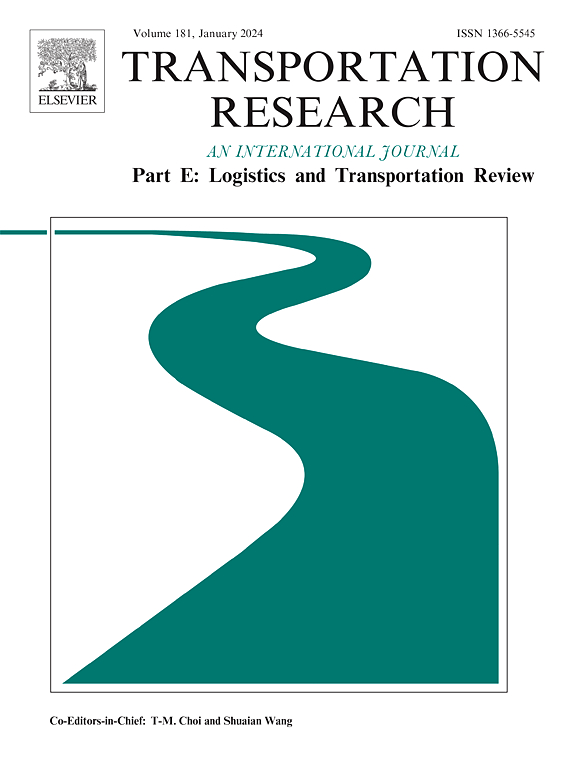A framework for collaborative UAM traffic flow optimization with mission preferences: Incorporating customized strategy synergy into strategic conflict management
IF 8.3
1区 工程技术
Q1 ECONOMICS
Transportation Research Part E-Logistics and Transportation Review
Pub Date : 2025-07-16
DOI:10.1016/j.tre.2025.104326
引用次数: 0
Abstract
Urban Air Mobility (UAM) is emerging as a transformative solution to urban transportation, yet the safe and efficient implementation requires advanced UAM traffic management approaches. Although existing studies prioritize the generation of conflict-free 4-D trajectories, critical mission-specific preferences remain insufficiently integrated, influencing stakeholders’ acceptance and operational feasibility. This paper addresses this gap by proposing a collaborative UAM Traffic Flow Management (UTFM) framework that models explicit interaction constraints, combining mission preferences with strategy synergy. The framework centers on the UTFM model featuring a hierarchical conflict management architecture. In the strategic phase, the deterministic separation threshold is applied to resolve 4-D conflicts proactively, while the pre-tactical phase employs probabilistic constraints to manage flight uncertainties during disruption recovery. To solve the UTFM problem, a novel two-stage optimization algorithm is developed. The first stage encodes the conflict-based solution space via recurrent path searching and linear mapping techniques, while the second stage optimizes the 4-D flight plans by determining strategy-specific decision variables. Additionally, the Transit Search Optimization (TSO) algorithm is introduced and enhanced through constraint transcription and normal cloud model. Comprehensive experiments demonstrate that the framework can generate robust and efficient flight plans under complex constraints with diverse mission preferences. The framework could support high-throughput UAM operations with customized requirements, offering a prototype for the advanced UAM traffic management system.
具有任务偏好的协同UAM交通流优化框架:将定制战略协同纳入战略冲突管理
城市空中交通(UAM)正在成为城市交通的变革性解决方案,但安全高效的实施需要先进的UAM交通管理方法。尽管现有研究优先考虑无冲突的4-D轨迹的生成,但关键任务特定偏好仍然没有充分整合,影响了利益攸关方的接受程度和操作可行性。本文通过提出一种协作式UAM交通流量管理(UTFM)框架来解决这一问题,该框架对明确的交互约束进行建模,将任务偏好与策略协同结合起来。该框架以具有分层冲突管理体系结构的UTFM模型为中心。在战略阶段,采用确定性分离阈值来主动解决四维冲突,而在战术前阶段,采用概率约束来管理中断恢复过程中的飞行不确定性。为了解决UTFM问题,提出了一种新的两阶段优化算法。第一阶段通过循环路径搜索和线性映射技术对基于冲突的解决方案空间进行编码,而第二阶段通过确定特定策略的决策变量来优化4d飞行计划。此外,介绍了Transit Search Optimization (TSO)算法,并通过约束转录和正常云模型对TSO算法进行了改进。综合实验表明,该框架能够在复杂约束条件下生成具有不同任务偏好的鲁棒高效飞行计划。该框架可以支持具有定制需求的高吞吐量UAM操作,为先进的UAM交通管理系统提供原型。
本文章由计算机程序翻译,如有差异,请以英文原文为准。
求助全文
约1分钟内获得全文
求助全文
来源期刊
CiteScore
16.20
自引率
16.00%
发文量
285
审稿时长
62 days
期刊介绍:
Transportation Research Part E: Logistics and Transportation Review is a reputable journal that publishes high-quality articles covering a wide range of topics in the field of logistics and transportation research. The journal welcomes submissions on various subjects, including transport economics, transport infrastructure and investment appraisal, evaluation of public policies related to transportation, empirical and analytical studies of logistics management practices and performance, logistics and operations models, and logistics and supply chain management.
Part E aims to provide informative and well-researched articles that contribute to the understanding and advancement of the field. The content of the journal is complementary to other prestigious journals in transportation research, such as Transportation Research Part A: Policy and Practice, Part B: Methodological, Part C: Emerging Technologies, Part D: Transport and Environment, and Part F: Traffic Psychology and Behaviour. Together, these journals form a comprehensive and cohesive reference for current research in transportation science.

 求助内容:
求助内容: 应助结果提醒方式:
应助结果提醒方式:


